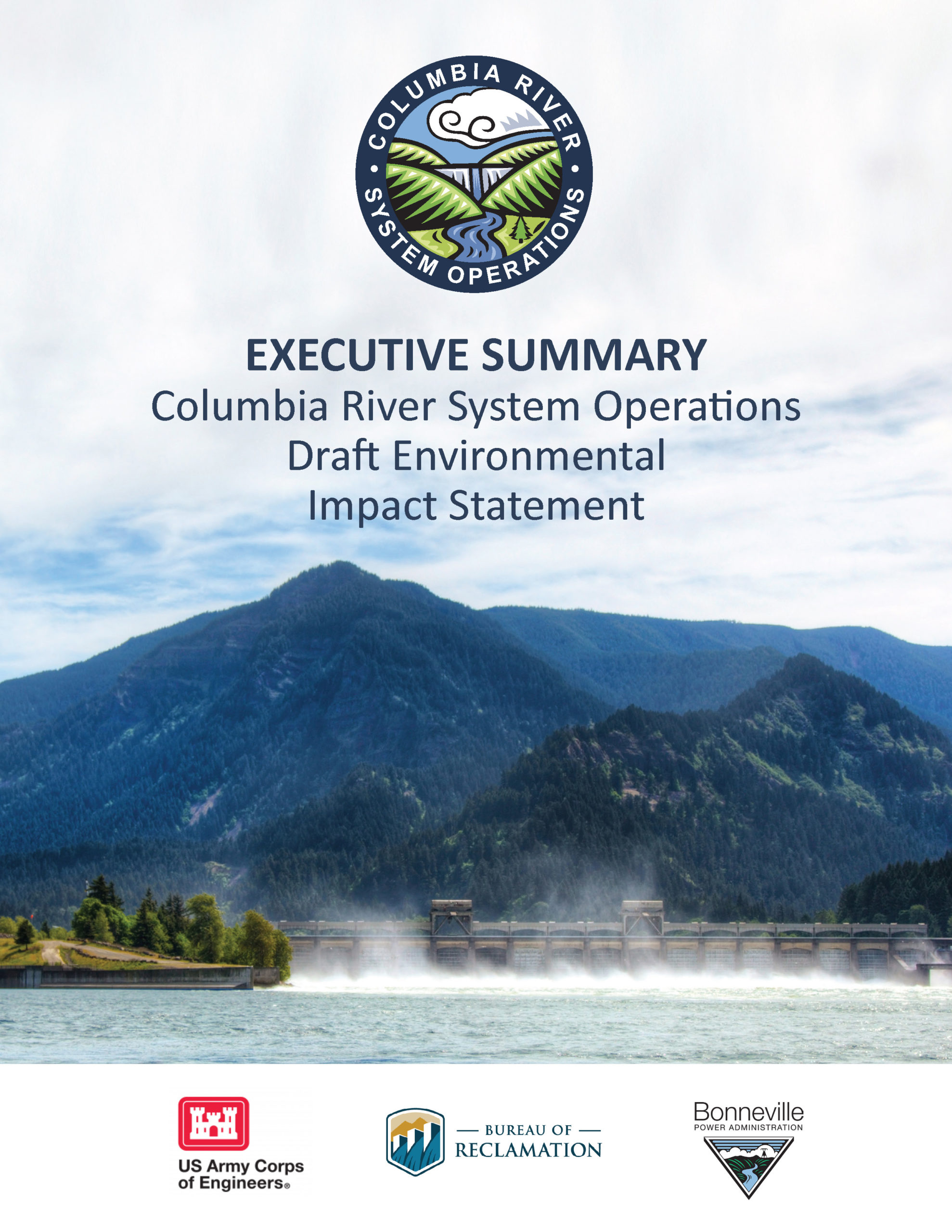The information provided below is a compilation of data from numerous websites, including Columbia River System Operations (CRSO), Pacific Northwest Waterways Association (PNWA), Northwest RiverPartners, and Snake River Dams.
The time is now! Take action to save our dams!
The U.S. Army Corps of Engineers, Bureau of Reclamation and the Bonneville Power Administration released the Columbia River Systems Operations Draft Environmental Impact Statement. The report evaluates recommendations on the future operations of the federal hydro system, including breaching the lower Snake River Dams.
As Washingtonians deal with the coronavirus and the ripple effects it’s having on business, education and daily life – reliable power is needed more than ever to deal with the crisis. Our thoughts and prayers go out the hundreds of families effected, those who are quarantined, hospitals treating patients with COVID-19 and the thousands of school children who are forced to stay home.
Now more than ever the importance of the lower Snake River dams becomes clear.
That’s why Tri-Cities leaders including Benton PUD, Franklin PUD, City of Richland Energy Services, Benton REA, Energy Northwest, Big Bend, TRIDEC, Port of Pasco, Port of Benton, Pasco Chamber, Tri-City Regional Chamber of Commerce, Visit Tri-Cities and many other are encouraging people across our region to participate in a series of upcoming public comment opportunities. The coronavirus has shifted the planned public meetings to a series of phone conferences. These conferences are scheduled for six days in March including the 17th, 18th, 19th, 25th, 26th and 31st.
Learn the facts, dates, times and how you can participate by visiting Pacific Northwest Waterways Association & Northwest RiverPartners sites:
All teleconferences begin at 4 p.m. Pacific / 5 p.m. Mountain time and are scheduled to end at 8 p.m. Pacific / 9 p.m. Mountain time. Participants will be able to comment (three-minute limit) and listen to others’ comments. For call-in numbers, visit the CRSO Submit Your Comment page.
Resources:
Columbia River System Operations EIS Resources:
- Submit Comment – By April 13, 2020
- Public Comment Teleconference Information
- Draft EIS Executive Summary
- Complete Draft EIS
Pacific Northwest Waterways Association (PNWA) Resources:
- Pacific Northwest Waterways Association (PNWA) River Values Website
- PNWA Sample Draft EIS Comment Information
- PNWA Dam Fact Sheet
Additional Websites:
Know the Dam Facts
Columbia River System Operations (CRSO)

Columbia River System Operations (CRSO) Draft EIS
You are invited to review and provide comments on the Draft Environmental Impact Statement and the Preferred Alternative for the operations, maintenance and configuration of the Columbia River System, comprised of 14 federal dam and reservoir projects in Idaho, Montana, Oregon and Washington. In accordance with the National Environmental Policy Act (NEPA), the draft EIS documents the review of potential actions and discloses the environmental effects of taking those actions.
The review and comment period opened on February 28, 2020 with the publication of the NEPA Notice of Availability in the Federal Register.
U.S. Army Corps of Engineers, Bureau of Reclamation and Bonneville Power Administration developed the draft EIS in response to the need to review and update management of the System, including evaluating impacts to resources in the context of new information and changed conditions in the Columbia River basin and in response to a court order by the U.S. District Court for the District of Oregon.
The Preferred Alternative detailed in the draft EIS is a suite of operational, maintenance and structural measures to allow the agencies to meet their congressionally authorized purposes, the Purpose and Need statement and EIS objectives, including those to benefit species listed as threatened and endangered under the Endangered Species Act. The agencies will respond to substantive comments on the draft EIS in the final EIS to be released this summer.
What is the CRSO DEIS?
Short for the Columbia River System Operations Draft Environmental Impact Statement, the CRSO DEIS is our first look at the comprehensive government analysis of the Northwest’s federally-operated hydro system. As part of the analysis, federal agencies were tasked with examining the lower Snake River dams—specifically, their impact on salmon and what purpose they serve for our region.
What was the outcome?
The study considered a range of preferred alternatives, including breaching all four dams. In the draft conclusion, the agencies recommended a combination of the alternatives to help communities and fish & wildlife. They also found that dam breaching was not the best alternative for our region.
What CRSO DEIS Indicated:
- Replacing the Lower Snake River dams with natural gas plants would add 3 million metric tons of carbon a year to the atmosphere.
- Cost $1 billion annually to replace the capabilities of the Lower Snake River dams with a carbon free portfolio of wind, solar, and batteries. Equating to a 25% jump in electricity bills for millions of electric customers in the Northwest.
- Breaching the Lower Snake River dams without replacing the generating capabilities would double the region’s risk of blackouts.
Why this matters:
If we truly want to save salmon, we need to heal our oceans. If we genuinely want our clean energy future to include everyone, we need it to be affordable. To do both, the Northwest needs the lower Snake River dams. To save our access to clean, affordable electricity, we need to unite together and ask that the federal agencies and the region recognize the true value of our hydro system. Our actions, or inactions, will shape and define the future of energy in the Northwest. There is perhaps no more critical time than now to get involved.
Know the Dam Facts
- The four lower Snake River dams include some of the most advanced and successful fish passage systems in the world.
- Young salmon headed downstream are surviving at 97% on average – rates similar to fish in undammed rivers.
- Columbia & Snake River dams move 50 million tons of commercial cargo and $20 billion of commerce every year.
- Fish returns for the past two decades are trending upward and 2014 was a record year for fish returns.
- Dam operators can start, stop, increase or decrease generation by hundreds of megawatts in seconds.
- Washington’s four lower Snake River dams produce more clean energy than all of WA’s wind and solar combined.
- Columbia and Snake River dams are vital to the 465-mile river highway, connecting Pacific Northwest farmers and businesses to the entire world market.
- Dams account for over two-thirds of WA’s total electricity generation completely carbon-free.
- Snake River dams produce over 1,000 megawatts of reliable, carbon-free clean energy. That’s enough to power almost 1 million U.S. homes.
- More than 90% of the City of Seattle and Seattle City Light’s electricity is generated from clean hydro power.
- Washington’s hydro power is changing the world by providing carbon-free clean energy to Canada and 14 other western states.
- Much of the year, Bonneville Power Administration (BPA) relies on lower Snake River dams specifically to help meet peak demands for energy.
- In just nine months in 2017, more than 3.5 million tons of cargo were barged on the Snake River.
- Pacific Northwest dams allow grain, fertilizers, potatoes, wood products and other commodities to move faster by river than train or truck – and with far less carbon emissions.
- According to a 2015 BPA study, replacing Snake River dams with highly efficient natural gas would increase carbon emissions by 2.0 to 2.6 metric tons annually.
- Washington is leading the nation into a clean energy future by regularly contributing more than one-fourth of U.S. total net hydroelectric generation.
- Each year, Snake River dams allow nearly 40 percent of all U.S. wheat exports to move via barge – the most fuel-efficient, safest, lowest emission type of cargo transportation.
- Scientists, biologists and engineers have equipped the four lower Snake River dams with the world’s most advanced fish passage systems.
- The Snake River system allows farmers to export grain and other crops grown in interior parts of the United States to overseas markets.
- The Snake River system allows farmers to export grain and other crops grown in interior parts of the United States to overseas markets.
- Between 50 and 60 million tons of cargo are transported each year on barges that can navigate the lower Snake River.
Dam News
April 5, 2020: “Editorial | Coronavirus is not excuse. Elected officials must allow public comments.” By Tri-City Herald Editorial Board, Tri-City Herald
March 26, 2020: “Guest Opinion: Here’s why we must save the Snake River dams. “ By Karl Dye, Lori Mattson, and Michael Novakovich, Tri-City Herald
March 26, 2020: “Breaching dams threatens basic necessity: electricity.” By Kurt Miller, Northwest RiverPartners, Yamhill Valley News Register
March 25, 2020: “Participate in the federal Snake River dams public process this week-the stakes are high.” By Kurt Miller, Northwest RiverPartners, Columbia Basin Herald Herald
March 22, 2020: “Editorial: Don’t let Snake River dams be a coronavirus casualty. Call in to save them.” By The Tri-City Herald Editorial Board, Tri-City Herald
March 09, 2020: “Fight to keep Snake River dams is not over. Supporters told to send comments to feds.” By Annette Cary, Tri-City Herald
March 04, 2020: “Guest Column: Preserving the lifeblood of the Pacific Northwest.” By Congressman Dan Newhouse, Sunnyside Sun
February 20, 2020: “Oregon Governor is off base. Breaching the Snake River dams is not the answer.” By The Tri-City Herald Editorial Board, Tri-City Herald
February 14, 2020: “Oregon Governor calls tearing out Snake dams the best salmon solution. State reps are outraged.” By Annette Cary, Tri-City Herald
January 24, 2020: “New Hydroelectric Turbine Design Aims to Improve Fish Passage at Snake River Dams.” By Courtney Flatt, Northwest Public Broadcasting
January 13, 2020: “Snake dams rally draws crowd in Tri-Cities.” By The Tri-City Herald Staff, Tri-City Herald
January 12, 2020: “Tonight: What Tri-Citians need to know about the dam rally and state meeting in Pasco.” By Annette Cary, Tri-City Herald
December 22, 2019: “Governor Inslee’s Snake River dam study wasted money telling us what we already know.” By The Tri-City Herald Editorial Board, Tri-City Herald
December 2019: “Snake River dam removal distracts from salmon recovery efforts.” By Todd Myers, Guest Contributor, Tri-Cities Area Journal of Business
December 18, 2019: “Washington Policy Center releases results of statewide poll on Snake River dams.” By Carissa Lehmkuhl, KAPP-TV|KVEW-TV
December 17, 2019: “Washington Policy Center’s poll on Snake River dams.” By Bob Brawdy, Tri-City Herald
December 12, 2019: “Feds sets Richland town hall on Columbia River Treaty. Salmon and hydropower are at stake.” By Tri-City Herald Staff, Tri-City Herald
December 9, 2019: “Dams| REBROADCAST: News Inside|Deschutes Library” By Julie Sabatier and Sage Van Wing, Oregon Public Broadcasting TV
November 20, 2019: “You can tell the state what you think of breaching Snake dams. Take its survey.” By Annette Cary, Tri-City Herald
August 7, 2019: “Editorial: Latest anti-dam study is ‘unscientific and inaccurate.’ It belongs in the trash.” By Tri-City Herald Editorial Board, Tri-City Herald
March 27, 2019: “Salmon and dams can coexist” By Mayor Don Britain, Mayor Matt Watkins, Mayor Robert Thompson, Mayor Brent Gerry, Special to the Seattle Times


